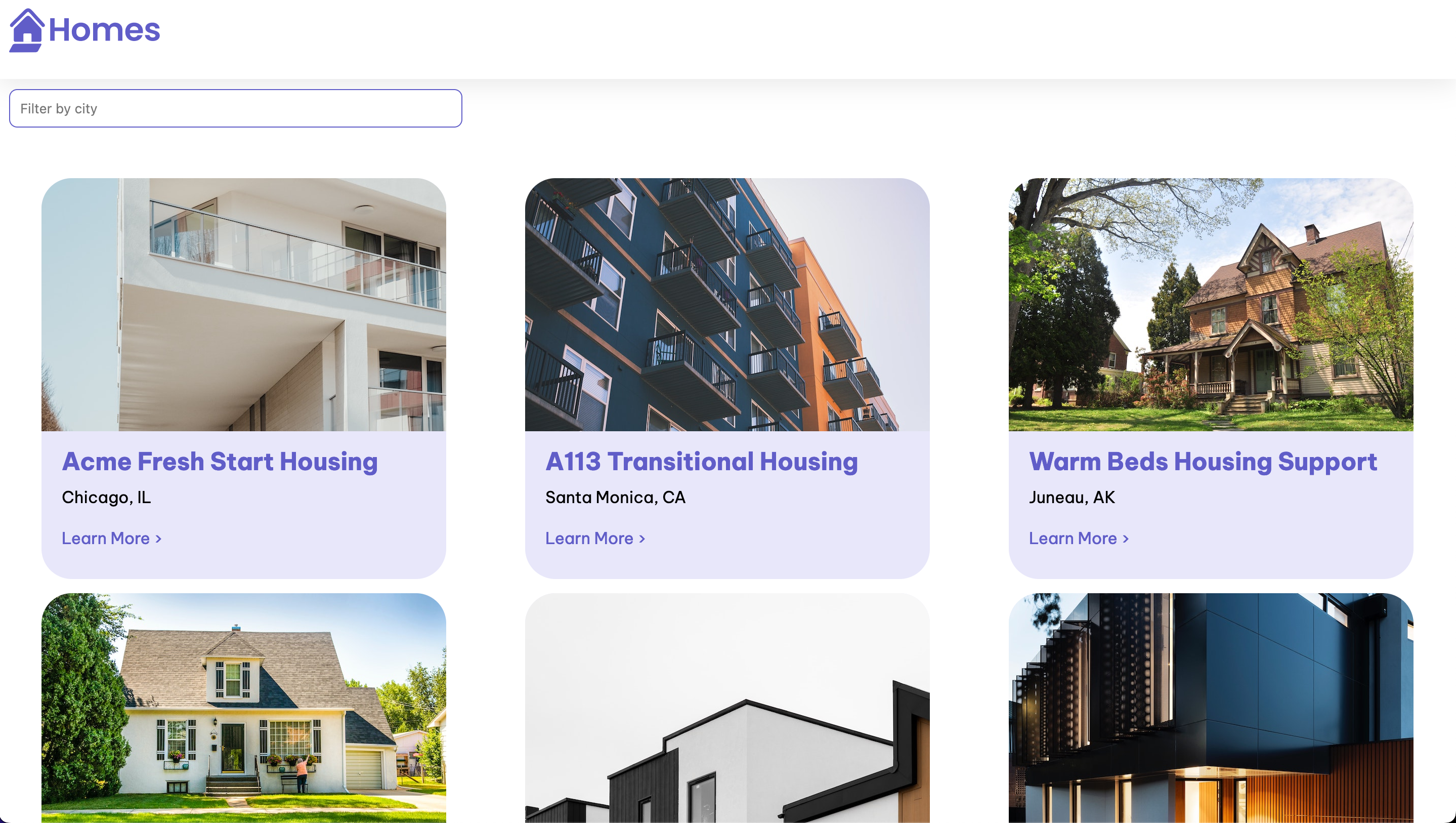A simple project to test out RxJS
This was my first time using RxJS (and TypeScript). Originally, I built this project from a tutorial, Your first Angular app.
This was a great learning experience but I also wanted to dive into RxJS. I wanted more of a practical understanding on using Observables, Operators, and the async pipe. I still have a long ways to go and my code is far from perfect, but coming out of this project, I have a better understanding of RxJS.
If you the reader see areas that I can improve on feel free to reach out or make a PR. I'm open and want to improve my skills.
This is a super simple home searching app! All you do is search a home by city (Chicago, Oakland, Gary, etc...) and watch the results populate as you type in the input.
Click on 'Learn More' to be redirected to the details page (Note: the form on submit does nothing but console.log the info sent).
Thats it!
Most of the RxJS action you'll find is in src/app/location.services.ts. Specifically this block below...
export class LocationService {
private locations$ = new BehaviorSubject<Location[]>([]);
// ...
public async init() {
this.locations$.next(this.allLocations);
// ^^^ allLocations is an array of Location objects.
}
public getLocations(): Observable<Location[]> {
return this.locations$;
}
public getLocationById(id: number): Observable<Location | undefined> {
return this.locations$.pipe(
map((locations) => {
return locations.find((location) => location.id === id);
})
);
}
}This service is injected into src/app/home/home.comonent.ts and src/app/details/details.component.ts where components can use observables to render correct data.
// src/app/home/home.comonent.ts
export class HomeComponent {
public locations$: Observable<Location[] | undefined>;
public filteredLocations$: Observable<Location[] | undefined>;
public locationService: LocationService = inject(LocationService);
public searchForm = new FormGroup({
query: new FormControl(""),
});
filterResults(text: string | null | undefined) {
if (!text) {
this.filteredLocations$ = this.locations$;
return;
}
this.filteredLocations$ = this.locationService.filterLocations(text);
}
constructor() {
this.locations$ = this.locationService.getLocations();
this.filteredLocations$ = this.locations$;
this.searchForm.valueChanges.subscribe((v) => this.filterResults(v.query));
this.locationService.init();
}
}// src/app/details.component.ts
export class DetailsComponent {
route: ActivatedRoute = inject(ActivatedRoute);
locationService = inject(LocationService);
housingLocation: Location | undefined;
location$: Observable<Location | undefined>;
// ...
constructor() {
this.location$ = this.route.paramMap.pipe(switchMap((params) => this.locationService.getLocations().pipe(map((locations) => (locations ? locations.find((location) => `${location.id}` === params.get("id")) : null)))));
this.locationService.init();
}
// ...
}Instead of having to subscribe to the observable from the component itself, I used the async pipe in templates
<!-- src/app/home/home.component.html -->
<section class="results">
<app-housing-location *ngFor="let location of filteredLocations$ | async" [location]="location"> </app-housing-location>
</section><!-- src/app/details/details.component.html -->
<ng-container *ngIf="location$ | async as location">
<article>
<img class="listing-photo" [src]="location?.photo" alt="Exterior photo of {{ location?.name}}" />
<section class="listing-description">
<h2 class="listing-heading">{{ location?.name}}</h2>
<p class="listing-location">{{location?.city}}, {{location?.state}}</p>
</section>
<section class="listing-features">
<h2 class="section-heading">About this housing location</h2>
<ul>
<li>Units available: {{location?.availableUnits}}</li>
<li>Does this location have wifi: {{ location?.wifi }}</li>
<li>Does this location have laundry: {{ location?.laundry }}</li>
</ul>
</section>
<section class="listing-apply">
<h2 class="section-heading">Apply now to live here</h2>
<form [formGroup]="applyForm" (submit)="submitApplication()">
<label for="first-name">First Name</label>
<input id="first-name" type="text" formControlName="firstName" />
<label for="last-name">Last Name</label>
<input id="last-name" type="text" formControlName="lastName" />
<label for="email">Email</label>
<input id="email" type="email" formControlName="email" />
<button type="submit" class="primary">Apply now</button>
</form>
</section>
</article>
</ng-container>Overall, I've enjoyed learning this library so far! I've just scratched the surface and still have a lot to understand but this was a great learning experience. To be continued...
